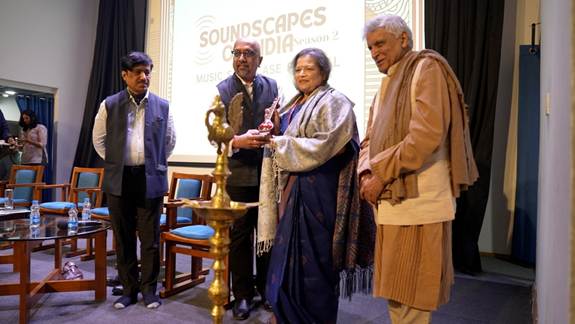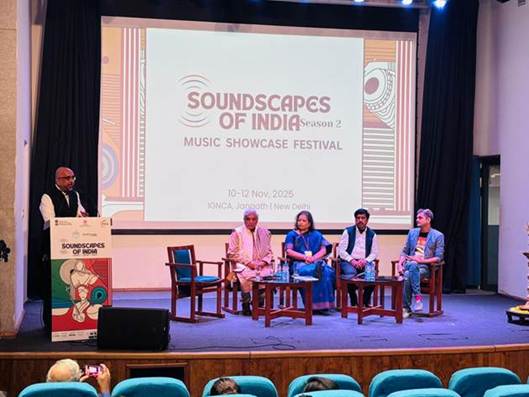Ministry of Culture
Poetry is the music of language, and music is the poetry of Sound: Javed Akhtar
Spectacular Opening of the Global Music Showcase – Soundscapes of India, Season 2
Posted On:
10 NOV 2025 10:01PM by PIB Delhi
The Indira Gandhi National Centre for the Arts (IGNCA), an autonomous institution under the aegis of the Ministry of Culture, witnessed the grand opening of the second season of Soundscapes of India — India’s first curated music showcase festival and global conference. The three-day festival, being held from 10–12 November, has been organised by the Indian Performing Right Society Limited (IPRS) with the support of the Ministry of Culture, Government of India, in collaboration with MusiConnect India.

The inaugural session was graced by Padma Bhushan Javed Akhtar; Smt. Amita Prasad Sarabhai, Additional Secretary, Ministry of Culture; Dr. Raghavender G. R., Senior Consultant (IPR) at the Department for Promotion of Industry and Internal Trade (DPIIT), Government of India; Mayur Puri, writer, lyricist, and member of the Board of Directors at IPRS; Mr. Rakesh Nigam, CEO, IPRS; and was anchored by Mrs. Rumpa Banerjee, Head – MarCom & Member Relations at IPRS.

Prior to the inaugural session Padma Bhushan Javed Akhtar, eminent poet, lyricist, and screenwriter, who also serves as the Chairman of IPRS, addressed a press conference where he spoke extensively about the festival and a range of related subjects. The session was also addressed by Mr. Rakesh Nigam, CEO, IPRS, and Mayur Puri, professional storyteller and screenwriter. On the first day, Javed Akhtar also led a special session on songwriting titled ‘The Art of Song Writing’.
In this session, Shri Akhtar explored the deep interrelation between poetry, music, and creativity. “Poetry is the music of language, and music is the poetry of sound,” he said, drawing parallels between poetic rhythm and musical harmony, and even linking this idea to Pythagoras’ philosophy of proportion and balance. Akhtar explained that both poetry and music are based on perfect meter, rhythm, and resonance, and when the two merge, “it becomes a marvellous combination that transcends linguistic and cultural boundaries and reaches people’s hearts.”
In a candid exchange, Shri Akhtar expressed his strong opinion on modern poetic trends, calling prose poetry “a deception” and “a fraud.” He explained that prose poetry, by removing melody and rhythm, loses the essence of poetry. “If it were poetic prose, it could be justified,” he noted, “but prose poetry takes away the raga and rhythm that define verse.” For him, the proof of true poetry lies in its melody.
He further elaborated that poetry develops symbols and meanings that connect even with untrained readers, provided it maintains discipline and rhythm. Writing poetry, he said, requires rigour and humility. “A poet should read poetry,” he insisted, adding that one must understand rhythm, sound, and phonetics deeply before attempting to write. Words, he observed, have lives of their own, developing relationships and impressions in the subconscious mind—a process central to authentic creation.
When asked about the decline in the quality of film lyrics, Shri Akhtar reflected that society itself mirrors its creative deterioration. “You tell me about the society, and I will tell you about its aesthetics,” he stated. He noted that with education increasingly focused on employment rather than understanding, literature and language have lost depth. “When the motive of learning is to earn, how it can carry the gravity of epic or lyrical expression?” he questioned.
On the subject of Artificial Intelligence (AI), Shri Akhtar commented, “AI may serve as an efficient tool, but it cannot be creative.” He noted, “Art is born in the no man’s land between the conscious and subconscious mind.” Every form of art, he said, is a blend of emotion, imagination, passion, and craftsmanship—qualities that no mechanical process can replicate. Reflecting on education and cultural understanding, he observed that society’s ability to appreciate art is diminishing. “Following one’s passion,” he said, “is like a river flowing toward the ocean—it finds its own path.”
During the press conference, Shri Akhtar described India as “a country of music,” highlighting its diverse and rich musical traditions. He said that regions such as Uttar Pradesh and the North East hold immense potential in the field of music that remains to be explored. Speaking about Soundscapes of India, he clarified, “This is not a talent hunt but a showcase of talent—an effort to bring creativity and the market together.”
Appreciating the support of the Ministry of Culture and IGNCA, Shri Akhtar acknowledged their crucial role in empowering artists and promoting unique cultural initiatives. The three-day festival at Indira Gandhi National Centre for the Arts features over 100 artists and 24 bands, including two international performers, and more than 15 global festival directors, curators, policymakers, and industry leaders. The performances encompass a wide range of musical expressions—from folk-fusion, classical-fusion, hip-hop, jazz, metal, pop, to rock. Linguistic diversity is another highlight, with songs being performed in English, Hindi, Konkani, Ladakhi, Tamil, and other Indian languages.

Speaking at the Cultural Ceremony of Soundscapes of India – Season 2, organised by IPRS with the support of the Ministry of Culture and venue partner IGNCA, Smt. Amita Prasad Sarabhai, Additional Secretary, Ministry of Culture, said, “The Ministry of Culture carries extensive responsibilities, along with the expectations of the artist community, which we are committed to upholding.” The Ministry oversees a wide range of institutions and academies — from the Anthropological Survey of India, Sangeet Natak Akademi, Sahitya Akademi, Lalit Kala Akademi, and teaching institutions like the National School of Drama and Kalakshetra Foundation, to the seven Zonal Cultural Centres dedicated to the preservation of folk and tribal art. Our museums — including the National Museum, Indian Museum, Salar Jung Museum, National Gallery of Modern Art, and Gandhi Smriti — each play a vital role in safeguarding India’s cultural legacy.
Institutions like IGNCA, under the leadership of Dr. Sachchidanand Joshi, continue to do phenomenal work in research and cultural documentation. I also want to acknowledge Soundscapes of India as a wonderful collaborative initiative by IPRS and the Ministry of culture — a creative confluence that truly bridges art, culture, and contemporary expression. Bands like Tal Fry performed last year and are opening this year as well, beautifully representing India internationally, and we look forward to many more such collaborations from the entertainment and cultural sectors.”
The event not only attracts music enthusiasts but also serves as a gateway to international opportunities for Indian artists. Representatives from 15 countries, including Canada, Egypt, Estonia, Germany, Indonesia, Japan, the Netherlands, Poland, Portugal, South Korea, Spain, and Thailand, are participating as festival directors, booking agents, and promoters. The previous edition of the festival had opened new avenues for several emerging Indian bands. For instance, the Bengali folk trio Bawl Mon gained international recognition through this platform and went on to represent India at the Busking World Cup in Gwangju, South Korea—where they not only participated but also won the title. Similarly, Delhi-based folk and classical-fusion percussion group Taal Fry performed at the prestigious Rainforest World Music Festival in Kuching, Malaysia, after their appearance at Soundscapes of India.

Soundscapes of India is not merely a music festival; it is a vibrant celebration of India’s cultural and linguistic diversity, connecting Indian musicians with the global music community. This initiative is a significant step toward positioning India not just as a consumer market, but as a creative and powerful musical force on the world stage. As India’s music industry continues to gain international recognition, festivals like Soundscapes of India reaffirm that the sounds of Indian music now resonate far beyond its borders—echoing across the world.
****
Sunil Kumar Tiwari
pibculture[at]gmail[dot]com
(Release ID: 2188595)
Visitor Counter : 950